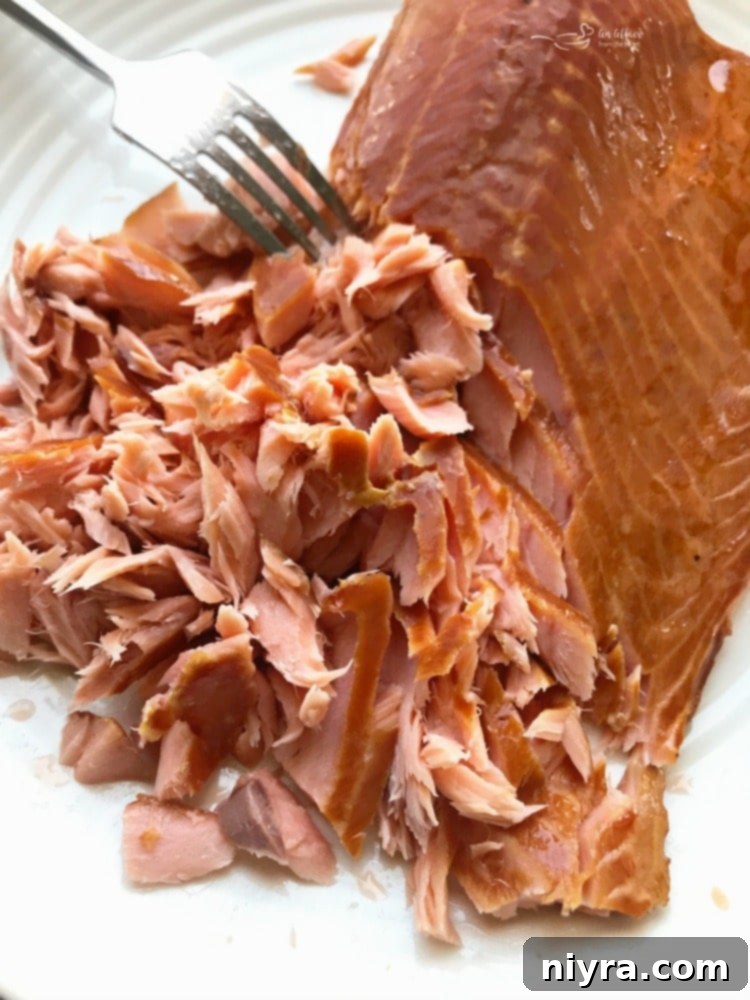Mastering Smoked Salmon: An Effortless Step-by-Step Guide to the Most Delicious, Moist, and Flavorful Fillets
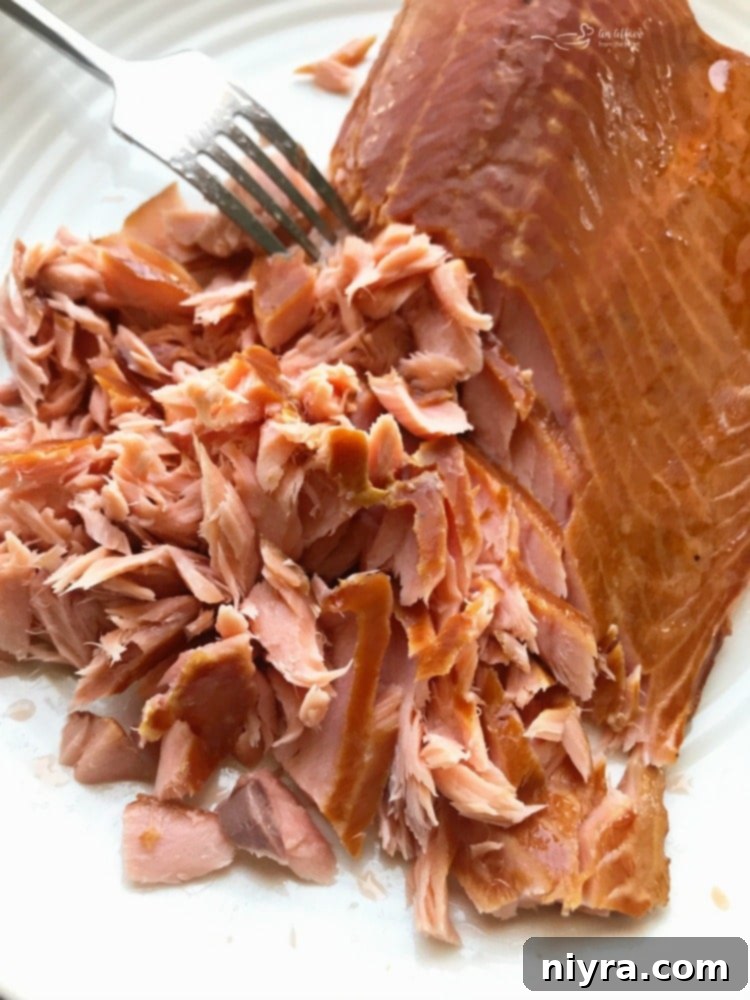
There’s an undeniable allure to smoked salmon. From its vibrant hue to its rich, complex flavor, it’s a culinary delight that has captivated palates for generations. Whether served as an elegant appetizer, a quick snack on crackers, or even incorporated into heartier meals, smoked salmon consistently impresses. For those who adore smoked fish, this comprehensive guide offers an unparalleled method to achieve perfectly moist and incredibly flavorful smoked salmon right in your own backyard. While this exceptional rub would elevate any fish, we’re focusing on salmon today, a true star that shines brightest with this smoking technique.
The beauty of homemade smoked salmon extends beyond its exquisite taste; it’s also about the sheer satisfaction of creating something so special from scratch. Forget store-bought options that often lack depth or can be overly dry. With this recipe, you’re guaranteed a product that rivals the best artisanal offerings, all while being surprisingly straightforward to execute. Get ready to transform a simple salmon fillet into a smoky masterpiece that will become a go-to for entertaining or simply treating yourself.
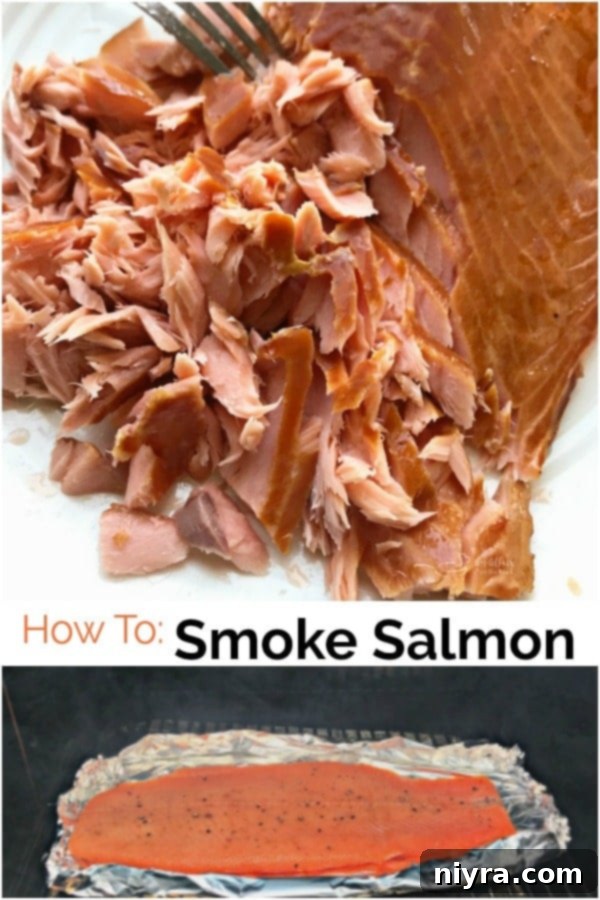
Why Smoke Salmon at Home? The Benefits of DIY
Smoking salmon at home isn’t just a hobby; it’s a rewarding culinary endeavor that offers several advantages over purchasing pre-smoked varieties:
- Unmatched Flavor Control: Craft your own rub and choose your wood pellets, allowing for a personalized flavor profile that perfectly suits your taste. This recipe’s unique rub, enhanced with molasses, delivers a depth of flavor that is truly remarkable.
- Superior Texture and Moisture: By controlling the brining and smoking process, you can achieve a supremely moist and flaky texture that is often elusive in commercially produced smoked salmon. Our method ensures the salmon remains tender and succulent.
- Cost-Effective: Buying whole salmon fillets and smoking them yourself can be significantly more economical than purchasing pre-packaged smoked salmon, especially when you factor in the quality difference.
- Impress Your Guests: There’s something inherently impressive about serving homemade smoked salmon. It’s a guaranteed conversation starter and a highlight of any gathering, from casual get-togethers to elegant dinner parties.
- Versatile Culinary Ingredient: Homemade smoked salmon is incredibly versatile. Enjoy it on its own, with crackers and cheese, or as a star ingredient in various dishes, from pasta to salads and beyond.
Last week, we delved into a delightful recipe for Smoked Salmon Pasta. It’s a dish so simple and quick to prepare, you’ll wonder why you hadn’t made it sooner – literally, dinner can be on the table in less than 20 minutes! While it might seem a bit unconventional to share the pasta recipe before its star ingredient, the smoked salmon itself, rest assured that today, you’re getting both sides of this delicious coin. This backward approach only highlights how indispensable perfectly smoked salmon is to so many amazing meals.

Special occasions often call for special food, and this smoked salmon recipe is perfect for celebrations. Recently, we celebrated my son’s graduation from the University of Nebraska at Lincoln. As a proud parent, witnessing his hard work culminate in a degree and a job at his dream company was truly wonderful. To mark this milestone, we hosted a gathering for family and friends, complete with cocktails and an array of appetizers. His requested menu was a delightful mix: Chips & Salsa from our local Mexican grocery, homemade Jalapeño Poppers, a generous meat and cheese tray, his God-Mother’s famous hamburger dip, a vibrant relish tray (this kid loves his veggies!), and of course, this incredible smoked salmon. For dessert, his favorites included Raspberry Thumbprint Cookies and playful Bubblegum Cupcakes. As you can see, there was no shortage of good food, and the smoked salmon was, as always, a standout hit. Now, let’s dive into the easy, step-by-step instructions to achieve these amazing results for your own smoked salmon masterpiece.
What You Need to Make This Amazing Smoked Salmon
To embark on your journey to perfectly smoked salmon, you’ll need a few key ingredients and some basic equipment. This recipe is designed to be accessible, yielding restaurant-quality results with minimal fuss.
Essential Ingredients:
- Salmon Fillet: A 2.5 to 3-pound salmon fillet is ideal. Look for a fresh, high-quality piece, preferably with the skin on one side. This size is manageable for most smokers and provides a generous yield.
- Brown Sugar: We use both light and dark brown sugar in this recipe. Dark brown sugar provides a richer, more caramel-like sweetness. If you only have light brown sugar, don’t worry – a simple trick with molasses will elevate it to perfection.
- Granulated Sugar: Balances the sweetness and contributes to the curing process.
- Molasses: A secret weapon! Adding a touch of molasses to light brown sugar not only deepens its color but also infuses the rub with an incredible richness and complexity that truly sets this smoked salmon apart.
- Kosher Salt: Essential for the brining process. Kosher salt has a larger crystal size than table salt, making it easier to measure and providing a more even cure without over-salting.
- Black Peppercorns: Freshly coarsely ground black peppercorns add a delightful pungency and aromatic warmth to the rub, complementing the sweet and salty flavors beautifully.
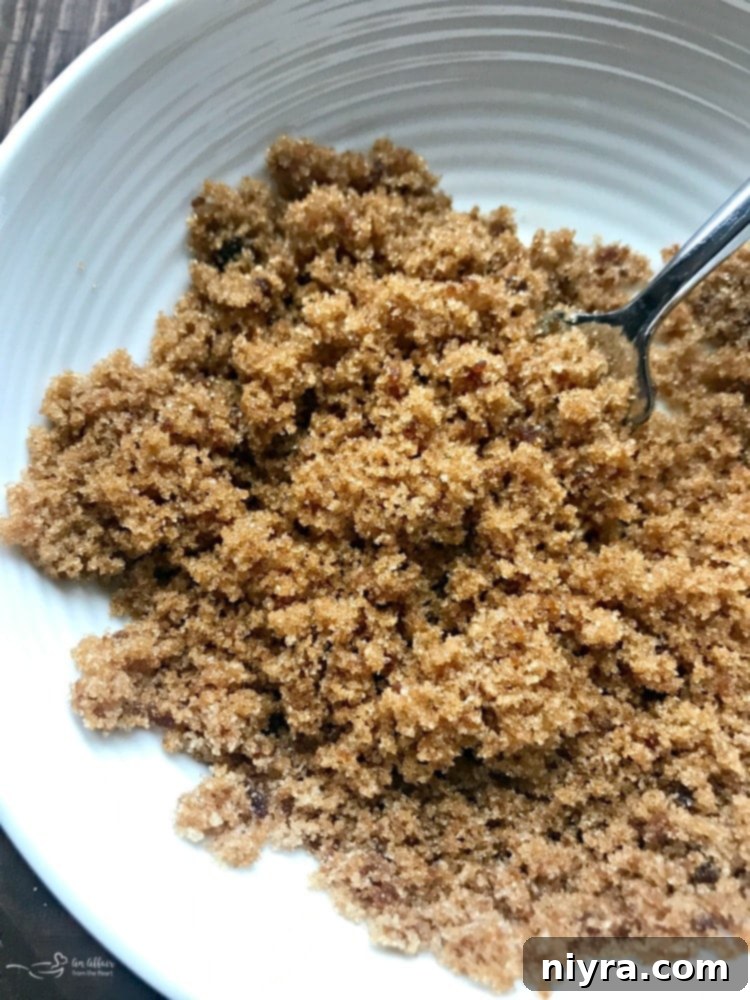
This recipe originally called for dark brown sugar, but on one occasion, I found myself with only light brown sugar in the pantry. Rather than adjust the recipe, I decided to experiment by adding some molasses to the light brown sugar. The results were nothing short of phenomenal! The molasses imparted such a rich, deep flavor that I’ve adopted this method ever since. It’s a simple trick that yields a vastly superior taste profile, proving sometimes the best innovations come from necessity.
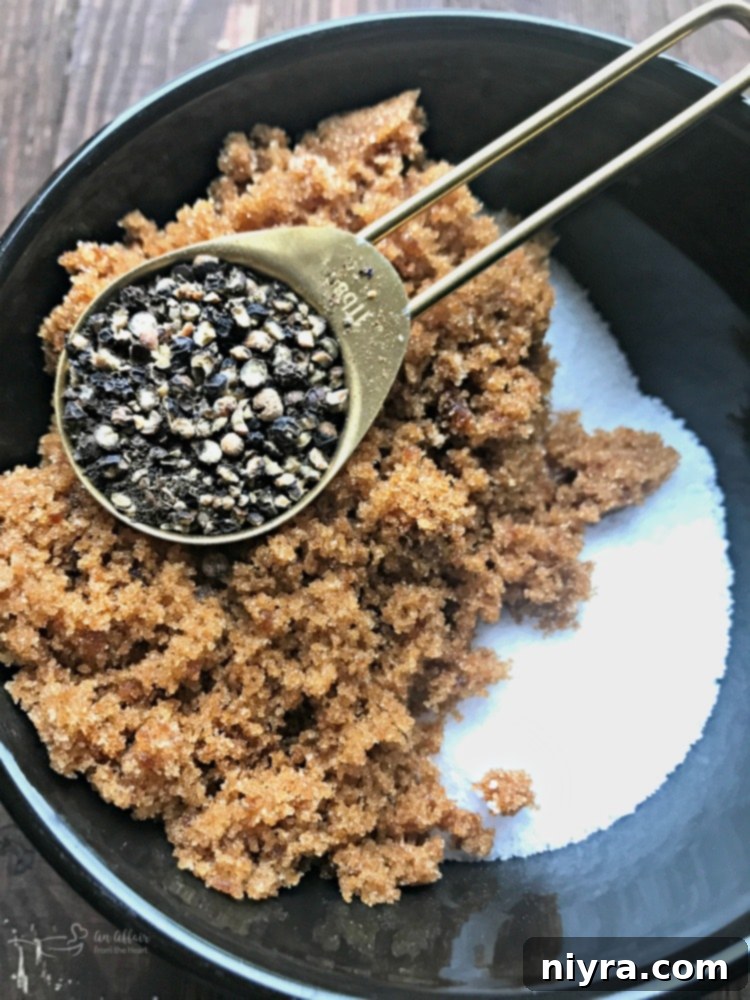
Combine the granulated sugar, light brown sugar (enhanced with molasses for that deep, rich flavor), kosher salt, and freshly coarsely ground black peppercorns.

Thoroughly mix all these ingredients together with a fork until they are uniformly combined. This will create your fantastic, flavorful rub, ready to transform your salmon.
Step-by-Step Guide to Perfect Smoked Salmon
Achieving perfectly smoked salmon is a process that requires patience and attention to detail, but each step is straightforward and contributes significantly to the final delicious outcome. Follow these instructions closely for a moist, flavorful fillet every time.
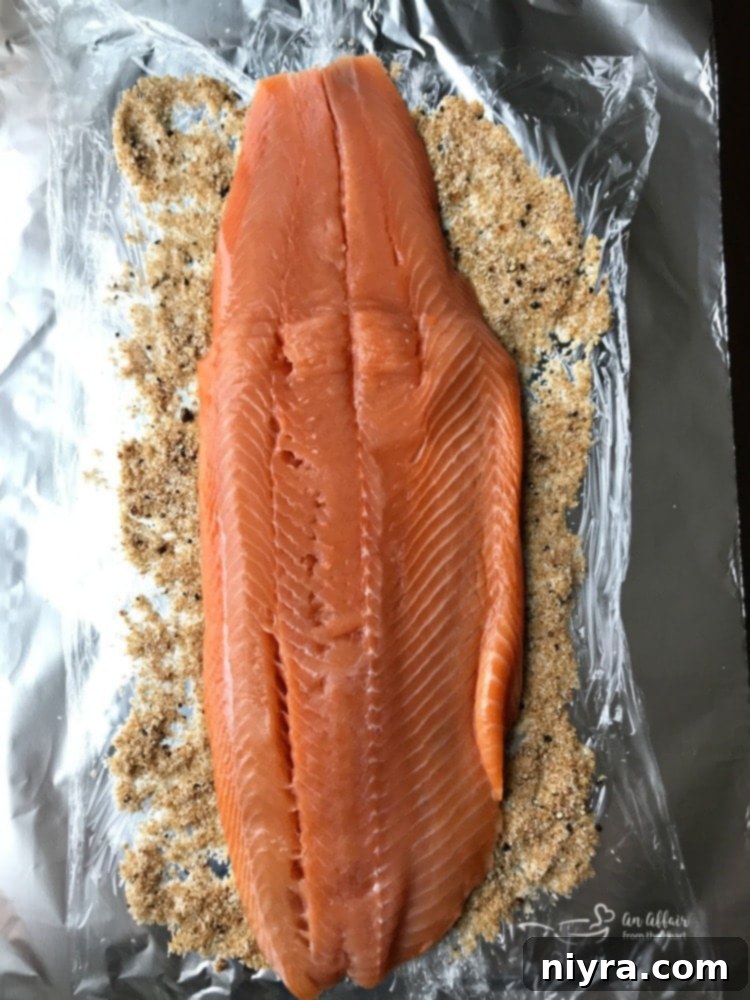
Step 1: Preparing the Salmon for Curing
On a clean counter, lay out two pieces of heavy-duty foil, overlapping slightly to create a strong base. Top this with a sheet of plastic wrap large enough to fully enclose your salmon fillet. Sprinkle about half of your prepared rub evenly over the plastic wrap where the salmon will rest. Now, carefully place your salmon fillet on top of the rub, skin-side down (if your fillet has skin). I often source my salmon fillets from Costco, finding them to be consistently good quality and a great value for their size.
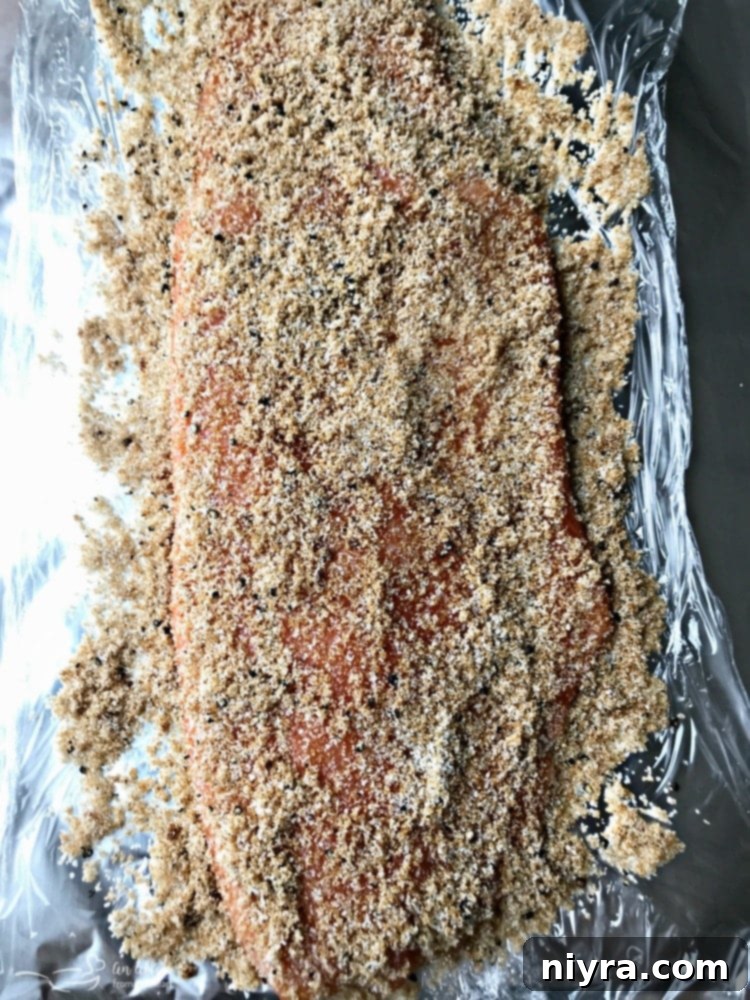
Step 2: Applying the Rub
With the salmon positioned on the first layer of rub, proceed to sprinkle and thoroughly coat the top side of the fillet with the remaining rub mixture. Ensure an even distribution across the entire surface of the fish. This full coverage is key to an effective cure and maximum flavor penetration.
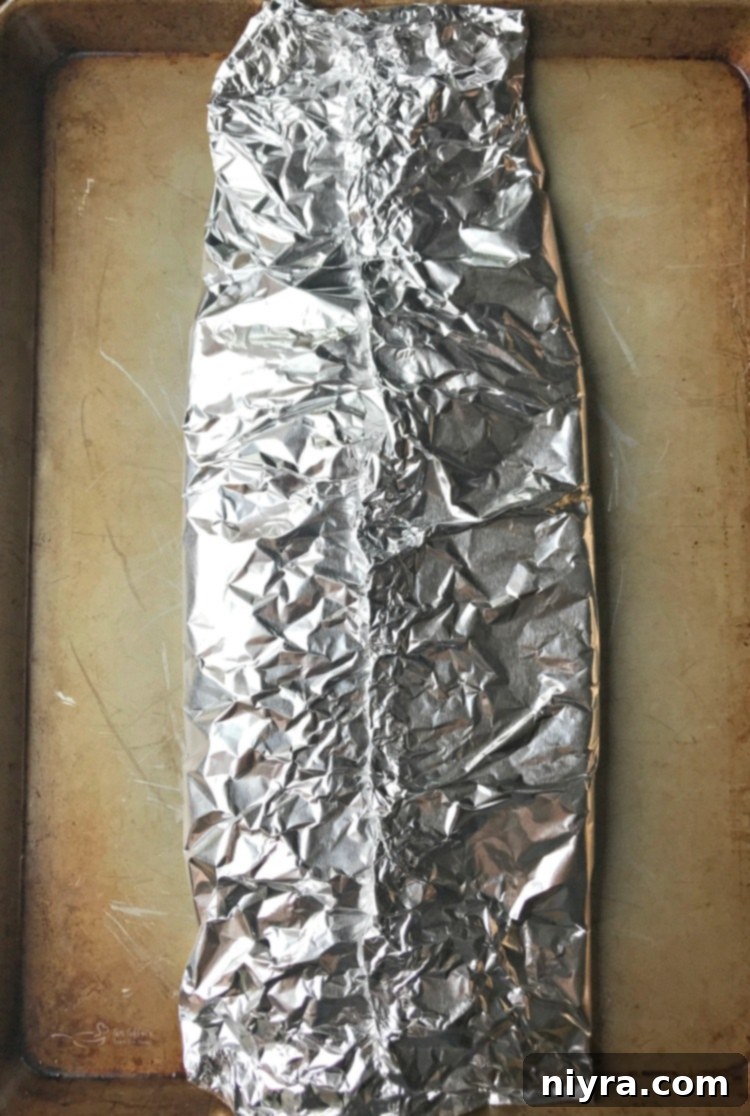
Step 3: The Curing Process (Brining)
Once fully coated, wrap the salmon tightly in the plastic wrap and then seal it snugly with the heavy-duty foil. Place the wrapped salmon on a cookie sheet (this is important, as some liquid will draw out during the curing process) and refrigerate it. After 12 hours, carefully flip the salmon package over on the cookie sheet. Return it to the fridge for another 12 hours. This 24-hour curing period allows the salt and sugar to penetrate the fish, drawing out moisture and firming up the flesh, which is crucial for the smoking process and achieving that desirable texture.
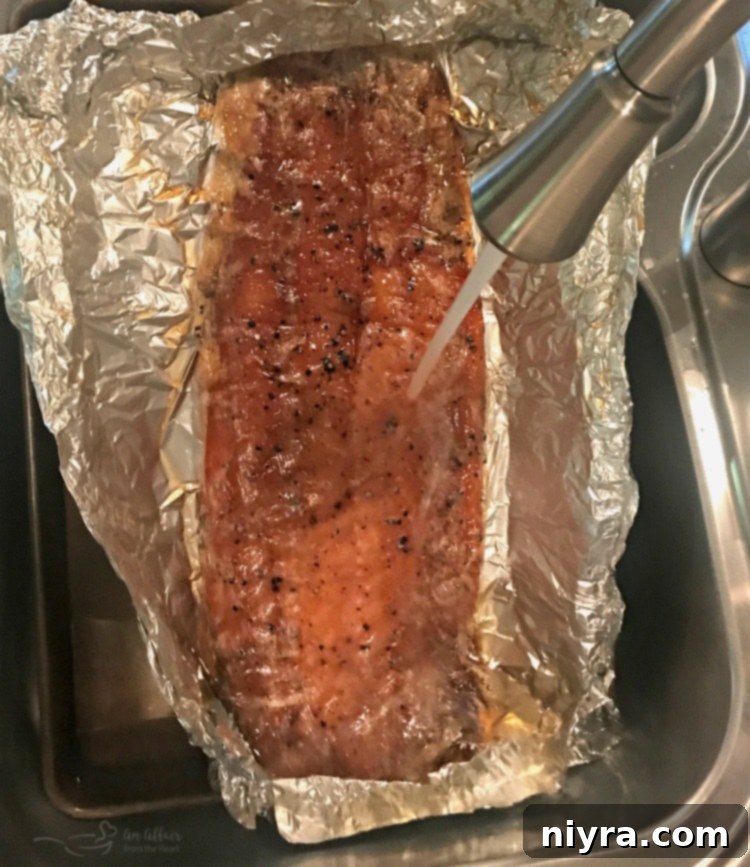
Step 4: Rinsing and Pellicle Formation
After the 24-hour curing period, unwrap the salmon. It’s now time for a crucial step: rinsing. Thoroughly rinse the salmon under cold running water to remove all traces of the rub. Don’t be shy – this ensures the final product isn’t overly salty. After rinsing, gently pat the salmon completely dry on both sides with paper towels. Return the dry fillet to a *clean* cookie sheet and place it in a cool, dry place overnight (do NOT return it to the fridge). This drying period allows a sticky, glossy layer called a “pellicle” to form on the surface. The pellicle is vital because it helps smoke adhere better to the fish, contributing to its rich color and flavor, and prevents a wet, soggy texture.
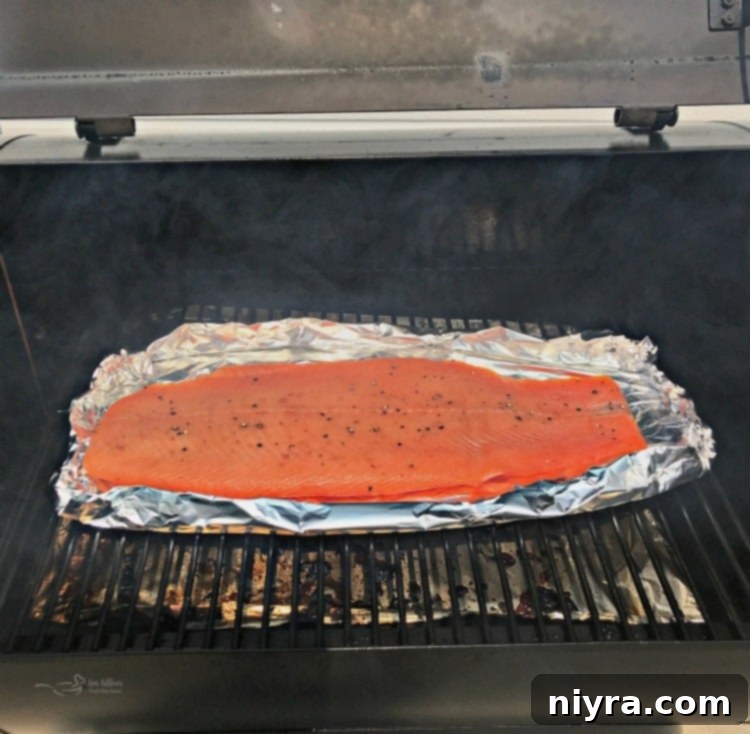
Step 5: The Smoking Process
When you’re ready to smoke, preheat your smoker to a consistent 200 degrees Fahrenheit. We recommend using Alder wood pellets for a classic, mild smoky flavor that perfectly complements salmon. Mesquite also works wonderfully if you prefer a slightly stronger smoke profile. Other great options include apple or cherry wood for a subtly sweet and fruity smoke. Place the salmon fillet on a couple of layers of heavy-duty foil with the edges slightly curled up to catch any drippings. Carefully transfer the foil-lined salmon to the preheated smoker grates.
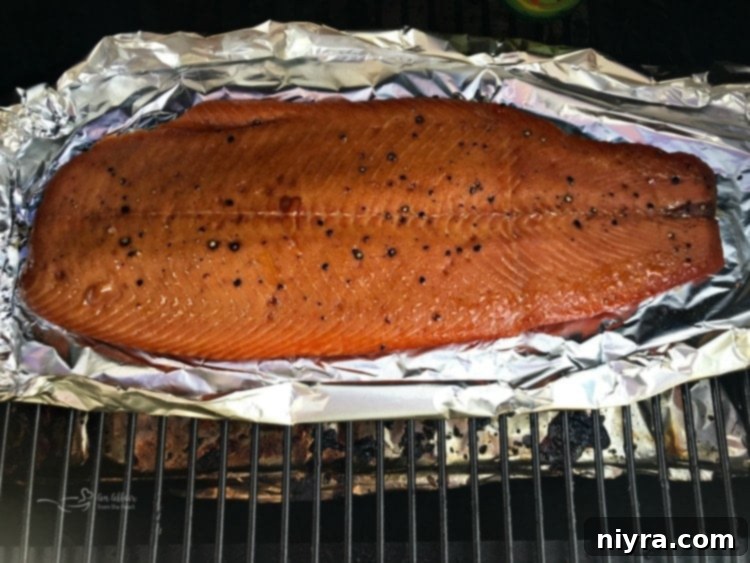
Step 6: Monitoring and Doneness
The smoking process for a 2.5-3 pound fillet typically takes around 2 hours, but this can vary depending on your smoker and the thickness of the fish. The most accurate way to determine doneness is by using an instant-read thermometer. Insert the thermometer into the thickest part of the salmon. The fish is perfectly done when it reaches an internal temperature of 160 degrees Fahrenheit. Avoid opening the smoker too frequently, as this causes temperature fluctuations and extends cooking time. Check the temperature after about 1 hour, then every 15-20 minutes thereafter until it reaches the target temperature. Once done, carefully remove the salmon from the smoker.
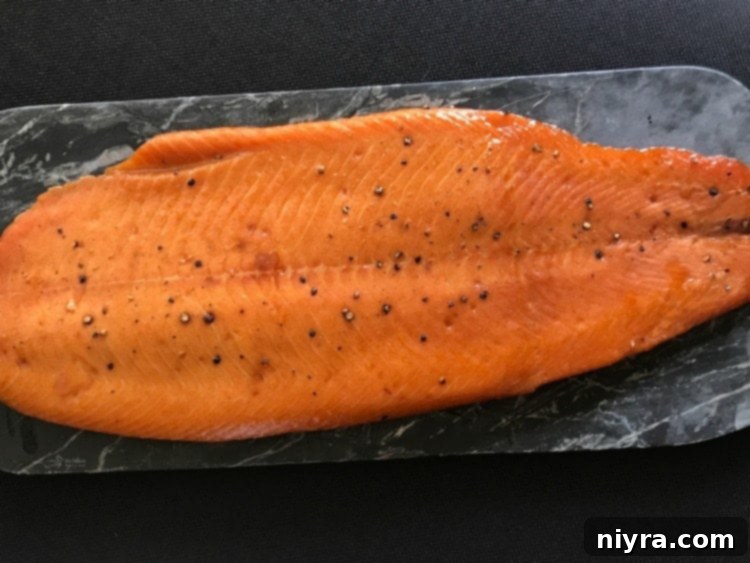
Step 7: Serving Your Smoked Salmon
Your freshly smoked salmon is ready to be enjoyed! You can plate it and serve it immediately while it’s still warm, or allow it to cool to room temperature before chilling it in the refrigerator. It’s truly delicious either way – the warm, smoky notes are fantastic straight off the smoker, while chilled smoked salmon offers a firmer texture and a refreshing experience.
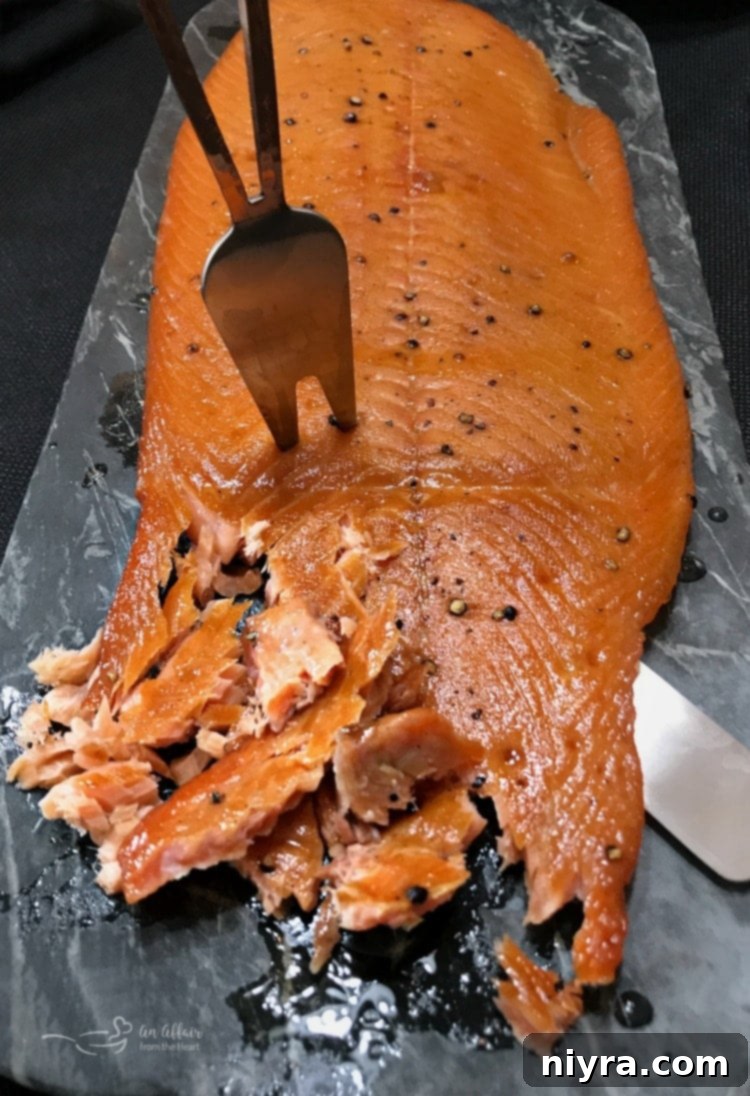
Creative Ways to Enjoy Your Homemade Smoked Salmon
Once you’ve mastered the art of smoking salmon, the culinary possibilities are endless! This versatile ingredient can elevate simple meals and create show-stopping appetizers. Here are some of our favorite ways to enjoy it:
- Classic Appetizer: Serve flaked or sliced smoked salmon with a variety of crackers, cream cheese, capers, fresh dill, and thinly sliced red onion. It’s a timeless and elegant starter.
- Brunch Favorite: A staple for any brunch spread! Pile generous amounts of smoked salmon onto toasted bagels with a thick schmear of cream cheese. Add a sprinkle of everything bagel seasoning or fresh chives for an extra touch.
- Smoked Salmon Pasta: Revisit our Smoked Salmon Pasta recipe for a quick and satisfying meal. The smoky richness of the salmon pairs beautifully with a creamy sauce and al dente pasta.
- Elevated Salads: Flake smoked salmon over a bed of mixed greens with avocado, cherry tomatoes, cucumber, and a light vinaigrette for a gourmet lunch or dinner.
- Scrambled Eggs or Omelets: Fold bits of smoked salmon into scrambled eggs or an omelet for a luxurious breakfast. Add some cream cheese and fresh herbs for an extra special touch.
- Canapés and Crostini: Top small toasts or cucumber slices with cream cheese, smoked salmon, and a sprig of fresh dill for elegant bite-sized appetizers.
- Smoked Salmon Dip: Blend leftover smoked salmon with cream cheese, sour cream, lemon juice, and seasonings for a delectable dip perfect with pita chips or vegetable sticks.
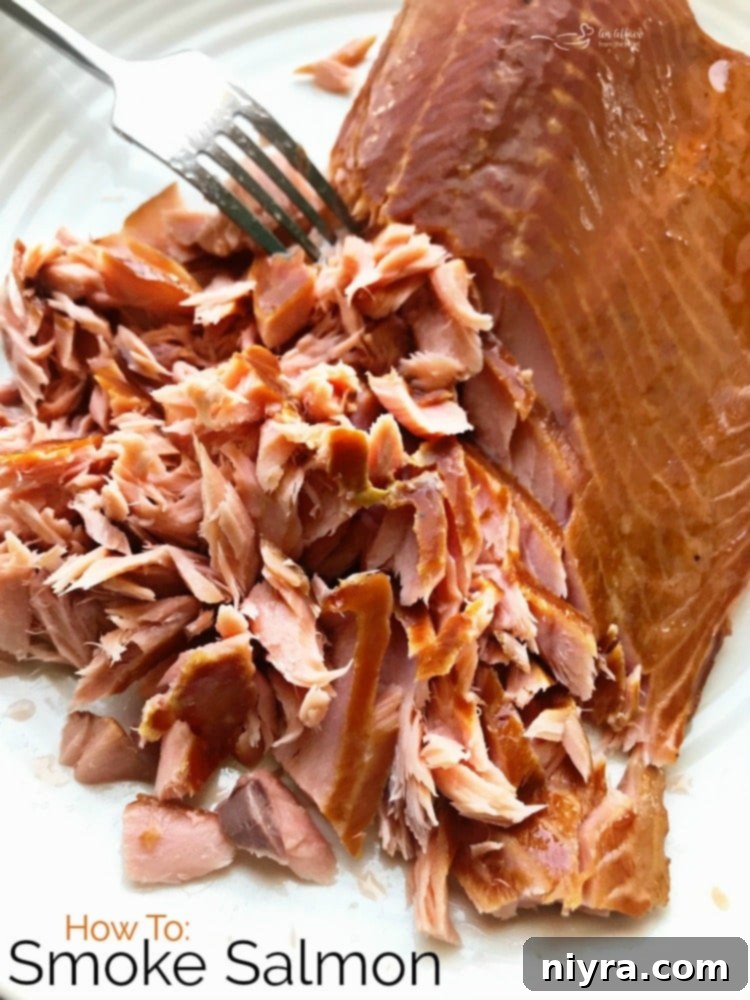
Storage Tips for Smoked Salmon
Proper storage is essential to keep your homemade smoked salmon fresh and delicious. Any leftovers should be stored in an airtight container in the refrigerator. It will typically remain fresh for up to 3 days. For longer storage, smoked salmon freezes exceptionally well. Wrap individual portions tightly in plastic wrap, then again in foil, and place them in a freezer-safe bag. It can be stored in the freezer for up to 3 months. Thaw frozen smoked salmon in the refrigerator overnight before use.
FAQs About Smoking Salmon
What kind of salmon is best for smoking?
King (Chinook) salmon is often considered the best due to its high fat content, which keeps it moist during smoking. Sockeye (Red) salmon offers a vibrant color and distinct flavor, while Atlantic salmon (often farmed) is widely available and also smokes beautifully. A good quality, fresh fillet with the skin on is always recommended.
Can I use a different type of smoker?
Absolutely! While a pellet smoker (like a Traeger) offers consistent temperature control and excellent smoke, you can use an electric smoker, charcoal smoker, or even a gas grill with a smoke box. The key is maintaining a low, consistent temperature (around 200°F) and providing a steady stream of smoke.
Why is the pellicle important?
The pellicle is a sticky protein layer that forms on the surface of the fish during the drying phase. It’s crucial because it helps the smoke adhere to the salmon, resulting in a richer color and deeper smoky flavor. It also prevents albumin (the white protein that sometimes leaches out) from forming unsightly white clumps on the surface.
What if my salmon is too salty?
If your smoked salmon tastes too salty, it likely means you didn’t rinse enough of the rub off after the curing process, or the curing time was too long for the thickness of the fillet. Ensure a thorough rinse next time, and consider adjusting the curing time for thinner fillets.
How do I know when the salmon is done without a thermometer?
While an internal thermometer is the most accurate, you can also look for visual cues. Smoked salmon should be firm to the touch, and when you gently flake it with a fork, it should separate easily. The color should be a rich, translucent orange-red throughout, without any raw-looking areas. However, for food safety and best results, a thermometer is always recommended.
Now that you’re equipped with all the knowledge and a fantastic recipe, who’s ready to smoke some salmon and savor the incredible results? Happy smoking!

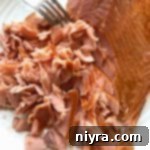
Smoked Salmon: How To Guide
36 mins
2 hours
~26 hours (includes cure time)
Ingredients
- 2/3 cup kosher salt
- 1/2 cup granulated sugar
- 1/2 cup light brown sugar mixed with 3 Tablespoons molasses
- 1 Tablespoon fresh coarsely ground black peppercorns
- 2.5-3 pound salmon fillet
Instructions
- Mix the light brown sugar and molasses together until well combined. Then, mix in the peppercorns, granulated sugar, and kosher salt.
- Lay two long sheets of heavy-duty foil flat on a cookie sheet, overlapping them slightly. Top with a sheet of plastic wrap large enough to cover the salmon. Sprinkle half of the prepared rub over the plastic wrap. Place the salmon fillet, skin side down, on the rub. Evenly coat the top of the salmon with the remaining rub. Wrap the salmon tightly in the plastic wrap, then seal it securely with the foil. Place the wrapped salmon on the cookie sheet and refrigerate.
- After 12 hours, flip the salmon package over on the cookie sheet. Return it to the fridge for another 12 hours. After the full 24-hour curing period, remove the salmon from the foil and plastic wrap. Rinse the salmon thoroughly under cold water to remove all traces of the rub. Pat dry with paper towels, and place it on a clean cookie sheet.
- Place the salmon on the cookie sheet in a cool, dry place overnight (do NOT return it to the fridge). This allows a pellicle to form, which helps the smoke adhere to the fish.
- Using Alder or Mesquite pellets (or your preferred smoking wood), preheat your smoker to 200 degrees Fahrenheit. Place the salmon on a couple of pieces of heavy-duty foil with the edges curled up to form a tray. Place the foil-lined salmon on the preheated smoker grates.
- Begin checking the internal temperature of the fish after about 1 hour of smoking. The salmon is done when the internal temperature reaches 160 degrees Fahrenheit in the thickest part of the fish. For a 2.5-3 pound fillet, this typically takes approximately 2 hours.
- Once done, remove the salmon from the smoker. Allow the salmon to cool to room temperature, or chill it in the refrigerator before serving.
- Store any remaining smoked salmon in an airtight container in the refrigerator for up to 3 days. It can also be frozen for longer storage.
Notes
Adapted from Alton Brown
